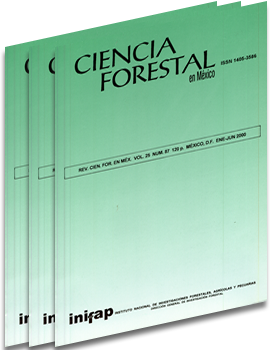ECOLOGÍA Y PRODUCCIÓN DE SÁBILA EN LA ZONA SEMIÁRIDA DE SAN LUIS POTOSÍ
Keywords:
Aloe vera, gel, random sampling, provenance, biomass production, AloeAbstract
Aloe (Aloe vera) an African species was introduced in Mexico in colonial times by the Spanish Jesuits. In San Luis Potosi, this species has been naturalized and is currently found from sea level up to 2,000 m. The species is growing near by rural settlements, forming round-shaped colon1es, usually thriving under the canopy of native trer· species. Plots of 3 x 3 m, div1ded in 9 subplots of 0.5 x 0.5 m were randomly C:istributed. In each of the subplots height of each individual plant, plant cover, frequency, and density were measured. The structural analysis of height indicated the presence of three dominant layers: 6-30, 31-60, and 61-90 cm. Dominant size-class was 31-60 cm with an importance index value of 206. Soil chemical determinations of the sar.ipled stands had an organic matter content of 1.5 to 9%, clay or silty loam texture, and pH from 7 to 7.8. Field evaluations of six aloe provenances managed under rainfed and irrigated conditions for seven and five years, respectively were not significant (p>0.05) for survival, root suckers per plant, height, gross total weight, gel biomass, and number of leaves per plant. Average biomass production was 161 ton ha-1 y(1 and 85 ton ha-1 y(1 for irrigated and rainfed conditions, respectively.
Downloads
Downloads
Published
How to Cite
Issue
Section
License
The authors who publish in Revista Mexicana de Ciencias Forestales accept the following conditions:
In accordance with copyright laws, Revista Mexicana de Ciencias Forestales recognizes and respects the authors’ moral right and ownership of property rights which will be transferred to the journal for dissemination in open access.
All the texts published by Revista Mexicana de Ciencias Forestales –with no exception– are distributed under a Creative Commons License Attribution-NonCommercial 4.0 International (CC BY-NC 4.0), which allows third parties to use the publication as long as the work’s authorship and its first publication in this journal are mentioned
The author(s) can enter into independent and additional contractual agreements for the nonexclusive distribution of the version of the article published in Revista Mexicana de Ciencias Forestales (for example, include it into an institutional repository or publish it in a book) as long as it is clearly and explicitly indicated that the work was published for the first time in Revista Mexicana de Ciencias Forestales.
For all the above, the authors shall send the form of Letter-transfer of Property Rights for the first publication duly filled in and signed by the author(s). This form must be sent as a PDF file to: ciencia.forestal2@inifap.gob.mx
This work is licensed under a Creative Commons Attribution-Noncommercial 4.0 International license.


